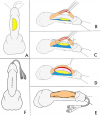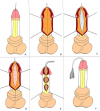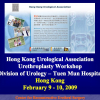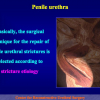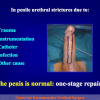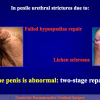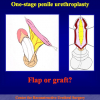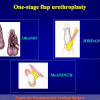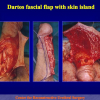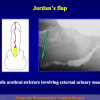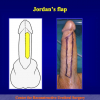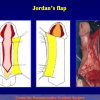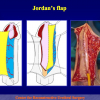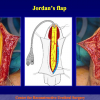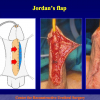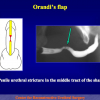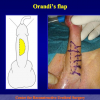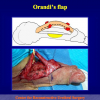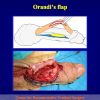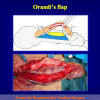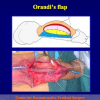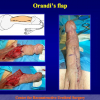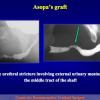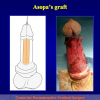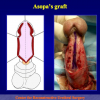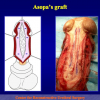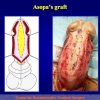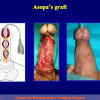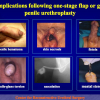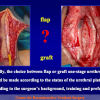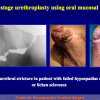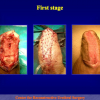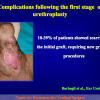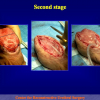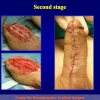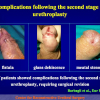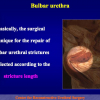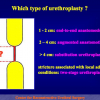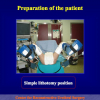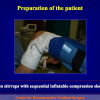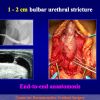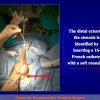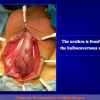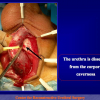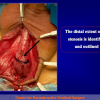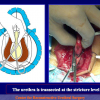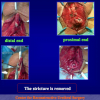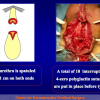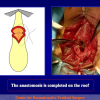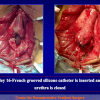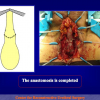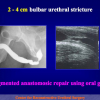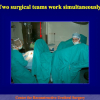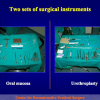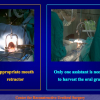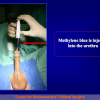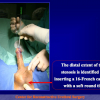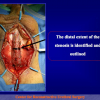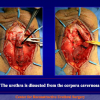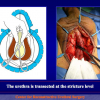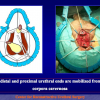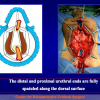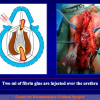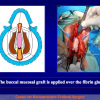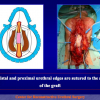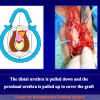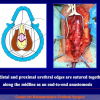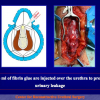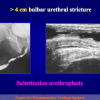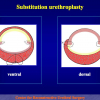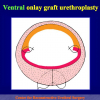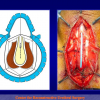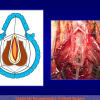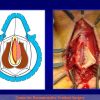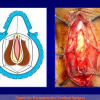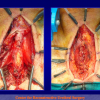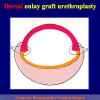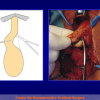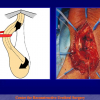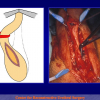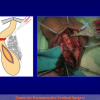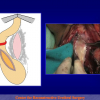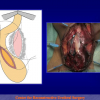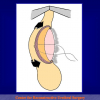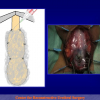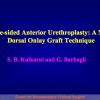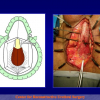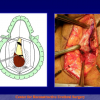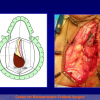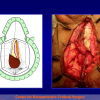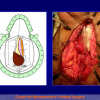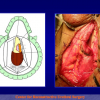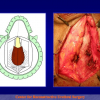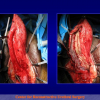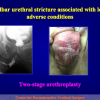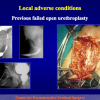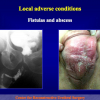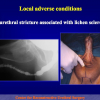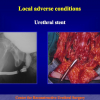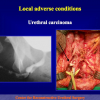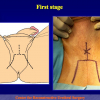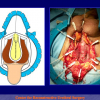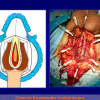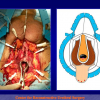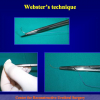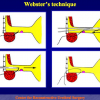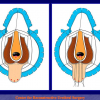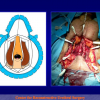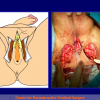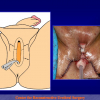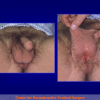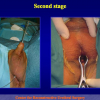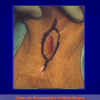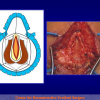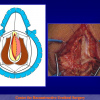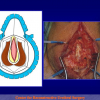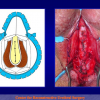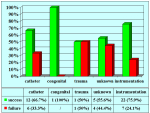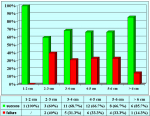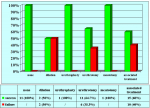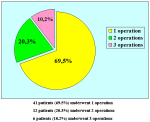The surgical technique of “One-stage penile urethroplasty with skin or oral mucosal graft” is made by opening the urethra at the level of the stricture site and widening the urethral lumen by applying a skin or oral graft. There are three basic types of One-stage penile urethroplasty:
- One-stage penile urethroplasty using skin flap. Using this technique, the urethral plate is augmented using a skin penile flap (figure 1).
- One-stage penile urethroplasty with oral mucosal graft. Using this technique, the urethral plate is augmented by a transplant of an oral graft (figure 2).
- One-stage penile urethroplasty with skin graft. Using this technique, the urethral plate is augmented by a transplant of a skin graft (figure 2).
The surgical technique of One-stage penile urethroplasty with skin or oral mucosal graft is generally suggested in the following cases:
- patients no-obliterative penile urethral strictures, more than 2 cm in length (figure 3).
|
Figure 1 |
Figure 2 |
Figure 3 |
Lecture n° 1:
| Which type of urethroplasty – a critical overview of results and complications 22nd Annual EAU Congress March 21-24, 2007 Berlin – Germany |
 Download PDF |
|
|
|
||
| Lecture n° 2: | ||
| Which type of urethroplasty. A critical overview of results and complications 23rd Annual EAU Congress ESU Course 8 March 26-29, 2008 Milan – Italy |
 Download PDF Download PDF |
|
|
|
||
| Lecture n° 3: | ||
| Penile Urethroplasty III Simposio Internacional de Cirurgia Urologica Reconstrutora April 11-12, 2008 Rio de Janeiro-Brazil |
 Download PDF Download PDF |
|
|
|
||
| Lecture n° 4: | ||
| Urethral Reconstructive Surgery: Current Trends Portuguese Andrological Association National Meeting June 21 – 23, 2008 Porto – Portugal |
 Download PDF Download PDF |
|
|
|
||
| Lecture n° 5: | ||
| Penile and bulbar urethroplasty Surgical techniques and results Hong Kong Urological Association Urethroplasty Workshop Division of Urology – Tuen Mun Hospital Hong Kong February 9 – 10, 2009 |
 Download PDF Download PDF |
Article n° 1
Barbagli G, Selli C, Tosto A, Palminteri E.
Dorsal free graft urethroplasty.
J Urol. 1996 Jan;155(1):123-6.
Article n° 2
Barbagli G, Palminteri E, Lazzeri M.
Dorsal onlay techniques for urethroplasty.
Urol Clin North Am. 2002 May;29(2):389-95.
Article n° 3
Barbagli G, Palminteri E, Balò S, Picinotti A, Lazzeri M,
Dorsal onlay graft urethroplasty. Current technique step-by-step.
Contemporary Urology, 2002: 14(5), 18-32
Article n° 4
Barbagli G, Palminteri E, Lazzeri M, Guazzoni G.
Anterior urethral strictures.
BJU Int. 2003 Sep;92(5):497-505.
Article n° 5
Barbagli G, Palminteri E, Bracka A, Caparros Sariol J.
Penile urethral reconstruction: concepts and concerns.
Arch Esp Urol. 2003 Jun;56(5):549-56.
Article n° 6
Barbagli G, Palminteri E, Lazzeri M, Bracka A.
Penile and bulbar urethroplasty using dorsal onlay techniques.
Atlas Urol Clin., 2003: 11, 29-41
Article n° 7
Guido Barbagli, Enzo Palminteri, Stefano De Stefani and Massimo Lazzeri
Penile urethroplasty: theniques and outcomes using buccal mucosa grafts.
Contemporary Urology. March 2006, 25-33
1. Question: What kind of anesthesia is used for this surgery?
Answer: General anesthesia with nasal tube.
2. Question: How many hours does the surgery take?
Answer: About 2 hours.
3. Question: Are there any risks concerning erection, fertility and urinary incontinence after the surgery?
Answer: No, there aren’t.
4. Question: How many days of hospital recovery are expected following the surgery?
Answer: In general, from 5 to 7 days.
5. Question: How long will I have to use a catheter after the surgery? Is it painful to use the catheter?
Answer: The catheter must stay in place for two or three weeks after the surgery. The catheter is well tolerated because of its small diameter.
6. Question: Are there any particular recommendations during convalescence?
Answer: During convalescence, the use antibiotics until the catheter is removed is suggested. Avoiding long car trips, as well as heavy labor and sexual and sports activities are also suggested.
7. Question: When will I be able to resume my working, sexual and sports activities?
Answer: All these activities can be gradually resumed about 30 days after the removal of the catheter.
8. Question: Can I ride a bike or a motorcycle immediately after the surgery?
Answer: Yes.
9. Question: What kinds of foods and drinks should be avoided after the surgery?
Answer: Beer and sparkling wines should be avoided, as well as large quantities of chocolate, cocoa, nuts and shellfish.
Answer: General anesthesia with nasal tube.
2. Question: How many hours does the surgery take?
Answer: About 2 hours.
3. Question: Are there any risks concerning erection, fertility and urinary incontinence after the surgery?
Answer: No, there aren’t.
4. Question: How many days of hospital recovery are expected following the surgery?
Answer: In general, from 5 to 7 days.
5. Question: How long will I have to use a catheter after the surgery? Is it painful to use the catheter?
Answer: The catheter must stay in place for two or three weeks after the surgery. The catheter is well tolerated because of its small diameter.
6. Question: Are there any particular recommendations during convalescence?
Answer: During convalescence, the use antibiotics until the catheter is removed is suggested. Avoiding long car trips, as well as heavy labor and sexual and sports activities are also suggested.
7. Question: When will I be able to resume my working, sexual and sports activities?
Answer: All these activities can be gradually resumed about 30 days after the removal of the catheter.
8. Question: Can I ride a bike or a motorcycle immediately after the surgery?
Answer: Yes.
9. Question: What kinds of foods and drinks should be avoided after the surgery?
Answer: Beer and sparkling wines should be avoided, as well as large quantities of chocolate, cocoa, nuts and shellfish.
| Up-to-date to 12-31-2021 | |||

Summarizing table |
|||
Surgical Technique: step by step
 Download PDF |

